+ Open data
Open data
- Basic information
Basic information
| Entry | Database: EMDB / ID: EMD-30400 | |||||||||
|---|---|---|---|---|---|---|---|---|---|---|
| Title | Cryo-EM structure of human NALCN in complex with FAM155A | |||||||||
 Map data Map data | Main map | |||||||||
 Sample Sample |
| |||||||||
 Keywords Keywords | Ion channel / MEMBRANE PROTEIN | |||||||||
| Function / homology |  Function and homology information Function and homology informationpositive regulation of synaptic transmission, cholinergic / leak channel activity / regulation of resting membrane potential / voltage-gated sodium channel activity / sodium channel activity / calcium ion import across plasma membrane / monoatomic ion channel complex / monoatomic cation channel activity / potassium ion transmembrane transport / sodium ion transmembrane transport ...positive regulation of synaptic transmission, cholinergic / leak channel activity / regulation of resting membrane potential / voltage-gated sodium channel activity / sodium channel activity / calcium ion import across plasma membrane / monoatomic ion channel complex / monoatomic cation channel activity / potassium ion transmembrane transport / sodium ion transmembrane transport / positive regulation of synaptic transmission, GABAergic / calcium ion transmembrane transport / Stimuli-sensing channels / monoatomic ion transmembrane transport / plasma membrane Similarity search - Function | |||||||||
| Biological species |  Homo sapiens (human) Homo sapiens (human) | |||||||||
| Method | single particle reconstruction / cryo EM / Resolution: 3.1 Å | |||||||||
 Authors Authors | Wu J / Yan Z | |||||||||
 Citation Citation |  Journal: Nat Commun / Year: 2020 Journal: Nat Commun / Year: 2020Title: Structure of the human sodium leak channel NALCN in complex with FAM155A. Authors: Jiongfang Xie / Meng Ke / Lizhen Xu / Shiyi Lin / Jin Huang / Jiabei Zhang / Fan Yang / Jianping Wu / Zhen Yan /  Abstract: NALCN, a sodium leak channel expressed mainly in the central nervous system, is responsible for the resting Na permeability that controls neuronal excitability. Dysfunctions of the NALCN ...NALCN, a sodium leak channel expressed mainly in the central nervous system, is responsible for the resting Na permeability that controls neuronal excitability. Dysfunctions of the NALCN channelosome, NALCN with several auxiliary subunits, are associated with a variety of human diseases. Here, we report the cryo-EM structure of human NALCN in complex with FAM155A at an overall resolution of 3.1 angstroms. FAM155A forms extensive interactions with the extracellular loops of NALCN that may help stabilize NALCN in the membrane. A Na ion-binding site, reminiscent of a Ca binding site in Ca channels, is identified in the unique EEKE selectivity filter. Despite its 'leaky' nature, the channel is closed and the intracellular gate is sealed by S6, II-III linker and III-IV linker. Our study establishes the molecular basis of Na permeation and voltage sensitivity, and provides important clues to the mechanistic understanding of NALCN regulation and NALCN channelosome-related diseases. | |||||||||
| History |
|
- Structure visualization
Structure visualization
| Movie |
 Movie viewer Movie viewer |
|---|---|
| Structure viewer | EM map:  SurfView SurfView Molmil Molmil Jmol/JSmol Jmol/JSmol |
| Supplemental images |
- Downloads & links
Downloads & links
-EMDB archive
| Map data |  emd_30400.map.gz emd_30400.map.gz | 4.4 MB |  EMDB map data format EMDB map data format | |
|---|---|---|---|---|
| Header (meta data) |  emd-30400-v30.xml emd-30400-v30.xml emd-30400.xml emd-30400.xml | 24.6 KB 24.6 KB | Display Display |  EMDB header EMDB header |
| Images |  emd_30400.png emd_30400.png | 38.2 KB | ||
| Filedesc metadata |  emd-30400.cif.gz emd-30400.cif.gz | 7.6 KB | ||
| Others |  emd_30400_additional_1.map.gz emd_30400_additional_1.map.gz emd_30400_additional_2.map.gz emd_30400_additional_2.map.gz emd_30400_half_map_1.map.gz emd_30400_half_map_1.map.gz emd_30400_half_map_2.map.gz emd_30400_half_map_2.map.gz | 833.9 KB 553.3 KB 49 MB 49 MB | ||
| Archive directory |  http://ftp.pdbj.org/pub/emdb/structures/EMD-30400 http://ftp.pdbj.org/pub/emdb/structures/EMD-30400 ftp://ftp.pdbj.org/pub/emdb/structures/EMD-30400 ftp://ftp.pdbj.org/pub/emdb/structures/EMD-30400 | HTTPS FTP |
-Validation report
| Summary document |  emd_30400_validation.pdf.gz emd_30400_validation.pdf.gz | 847.2 KB | Display |  EMDB validaton report EMDB validaton report |
|---|---|---|---|---|
| Full document |  emd_30400_full_validation.pdf.gz emd_30400_full_validation.pdf.gz | 846.7 KB | Display | |
| Data in XML |  emd_30400_validation.xml.gz emd_30400_validation.xml.gz | 11.8 KB | Display | |
| Data in CIF |  emd_30400_validation.cif.gz emd_30400_validation.cif.gz | 14 KB | Display | |
| Arichive directory |  https://ftp.pdbj.org/pub/emdb/validation_reports/EMD-30400 https://ftp.pdbj.org/pub/emdb/validation_reports/EMD-30400 ftp://ftp.pdbj.org/pub/emdb/validation_reports/EMD-30400 ftp://ftp.pdbj.org/pub/emdb/validation_reports/EMD-30400 | HTTPS FTP |
-Related structure data
| Related structure data |  7cm3MC M: atomic model generated by this map C: citing same article ( |
|---|---|
| Similar structure data |
- Links
Links
| EMDB pages |  EMDB (EBI/PDBe) / EMDB (EBI/PDBe) /  EMDataResource EMDataResource |
|---|---|
| Related items in Molecule of the Month |
- Map
Map
| File |  Download / File: emd_30400.map.gz / Format: CCP4 / Size: 52.7 MB / Type: IMAGE STORED AS FLOATING POINT NUMBER (4 BYTES) Download / File: emd_30400.map.gz / Format: CCP4 / Size: 52.7 MB / Type: IMAGE STORED AS FLOATING POINT NUMBER (4 BYTES) | ||||||||||||||||||||||||||||||||||||||||||||||||||||||||||||||||||||
|---|---|---|---|---|---|---|---|---|---|---|---|---|---|---|---|---|---|---|---|---|---|---|---|---|---|---|---|---|---|---|---|---|---|---|---|---|---|---|---|---|---|---|---|---|---|---|---|---|---|---|---|---|---|---|---|---|---|---|---|---|---|---|---|---|---|---|---|---|---|
| Annotation | Main map | ||||||||||||||||||||||||||||||||||||||||||||||||||||||||||||||||||||
| Projections & slices | Image control
Images are generated by Spider. | ||||||||||||||||||||||||||||||||||||||||||||||||||||||||||||||||||||
| Voxel size | X=Y=Z: 1.087 Å | ||||||||||||||||||||||||||||||||||||||||||||||||||||||||||||||||||||
| Density |
| ||||||||||||||||||||||||||||||||||||||||||||||||||||||||||||||||||||
| Symmetry | Space group: 1 | ||||||||||||||||||||||||||||||||||||||||||||||||||||||||||||||||||||
| Details | EMDB XML:
CCP4 map header:
| ||||||||||||||||||||||||||||||||||||||||||||||||||||||||||||||||||||
-Supplemental data
-Additional map: Extracellular region
| File | emd_30400_additional_1.map | ||||||||||||
|---|---|---|---|---|---|---|---|---|---|---|---|---|---|
| Annotation | Extracellular region | ||||||||||||
| Projections & Slices |
| ||||||||||||
| Density Histograms |
-Additional map: Intracellular region
| File | emd_30400_additional_2.map | ||||||||||||
|---|---|---|---|---|---|---|---|---|---|---|---|---|---|
| Annotation | Intracellular region | ||||||||||||
| Projections & Slices |
| ||||||||||||
| Density Histograms |
-Half map: half map1
| File | emd_30400_half_map_1.map | ||||||||||||
|---|---|---|---|---|---|---|---|---|---|---|---|---|---|
| Annotation | half map1 | ||||||||||||
| Projections & Slices |
| ||||||||||||
| Density Histograms |
-Half map: halp map2
| File | emd_30400_half_map_2.map | ||||||||||||
|---|---|---|---|---|---|---|---|---|---|---|---|---|---|
| Annotation | halp map2 | ||||||||||||
| Projections & Slices |
| ||||||||||||
| Density Histograms |
- Sample components
Sample components
-Entire : Binary complex of human NALCN with FAM155A
| Entire | Name: Binary complex of human NALCN with FAM155A |
|---|---|
| Components |
|
-Supramolecule #1: Binary complex of human NALCN with FAM155A
| Supramolecule | Name: Binary complex of human NALCN with FAM155A / type: complex / ID: 1 / Parent: 0 / Macromolecule list: #1-#2 |
|---|---|
| Source (natural) | Organism:  Homo sapiens (human) Homo sapiens (human) |
-Macromolecule #1: Sodium leak channel non-selective protein
| Macromolecule | Name: Sodium leak channel non-selective protein / type: protein_or_peptide / ID: 1 / Number of copies: 1 / Enantiomer: LEVO |
|---|---|
| Source (natural) | Organism:  Homo sapiens (human) Homo sapiens (human) |
| Molecular weight | Theoretical: 203.616953 KDa |
| Recombinant expression | Organism:  Homo sapiens (human) Homo sapiens (human) |
| Sequence | String: MLKRKQSSRV EAQPVTDFGP DESLSDNADI LWINKPWVHS LLRICAIISV ISVCMNTPMT FEHYPPLQYV TFTLDTLLMF LYTAEMIAK MHIRGIVKGD SSYVKDRWCV FDGFMVFCLW VSLVLQVFEI ADIVDQMSPW GMLRIPRPLI MIRAFRIYFR F ELPRTRIT ...String: MLKRKQSSRV EAQPVTDFGP DESLSDNADI LWINKPWVHS LLRICAIISV ISVCMNTPMT FEHYPPLQYV TFTLDTLLMF LYTAEMIAK MHIRGIVKGD SSYVKDRWCV FDGFMVFCLW VSLVLQVFEI ADIVDQMSPW GMLRIPRPLI MIRAFRIYFR F ELPRTRIT NILKRSGEQI WSVSIFLLFF LLLYGILGVQ MFGTFTYHCV VNDTKPGNVT WNSLAIPDTH CSPELEEGYQ CP PGFKCMD LEDLGLSRQE LGYSGFNEIG TSIFTVYEAA SQEGWVFLMY RAIDSFPRWR SYFYFITLIF FLAWLVKNVF IAV IIETFA EIRVQFQQMW GSRSSTTSTA TTQMFHEDAA GGWQLVAVDV NKPQGRAPAC LQKMMRSSVF HMFILSMVTV DVIV AASNY YKGENFRRQY DEFYLAEVAF TVLFDLEALL KIWCLGFTGY ISSSLHKFEL LLVIGTTLHV YPDLYHSQFT YFQVL RVVR LIKISPALED FVYKIFGPGK KLGSLVVFTA SLLIVMSAIS LQMFCFVEEL DRFTTFPRAF MSMFQILTQE GWVDVM DQT LNAVGHMWAP VVAIYFILYH LFATLILLSL FVAVILDNLE LDEDLKKLKQ LKQSEANADT KEKLPLRLRI FEKFPNR PQ MVKISKLPSD FTVPKIRESF MKQFIDRQQQ DTCCLLRSLP TTSSSSCDHS KRSAIEDNKY IDQKLRKSVF SIRARNLL E KETAVTKILR ACTRQRMLSG SFEGQPAKER SILSVQHHIR QERRSLRHGS NSQRISRGKS LETLTQDHSN TVRYRNAQR EDSEIKMIQE KKEQAEMKRK VQEEELRENH PYFDKPLFIV GREHRFRNFC RVVVRARFNA SKTDPVTGAV KNTKYHQLYD LLGLVTYLD WVMIIVTICS CISMMFESPF RRVMHAPTLQ IAEYVFVIFM SIELNLKIMA DGLFFTPTAV IRDFGGVMDI F IYLVSLIF LCWMPQNVPA ESGAQLLMVL RCLRPLRIFK LVPQMRKVVR ELFSGFKEIF LVSILLLTLM LVFASFGVQL FA GKLAKCN DPNIIRREDC NGIFRINVSV SKNLNLKLRP GEKKPGFWVP RVWANPRNFN FDNVGNAMLA LFEVLSLKGW VEV RDVIIH RVGPIHGIYI HVFVFLGCMI GLTLFVGVVI ANFNENKGTA LLTVDQRRWE DLKSRLKIAQ PLHLPPRPDN DGFR AKMYD ITQHPFFKRT IALLVLAQSV LLSVKWDVED PVTVPLATMS VVFTFIFVLE VTMKIIAMSP AGFWQSRRNR YDLLV TSLG VVWVVLHFAL LNAYTYMMGA CVIVFRFFSI CGKHVTLKML LLTVVVSMYK SFFIIVGMFL LLLCYAFAGV VLFGTV KYG ENINRHANFS SAGKAITVLF RIVTGEDWNK IMHDCMVQPP FCTPDEFTYW ATDCGNYAGA LMYFCSFYVI IAYIMLN LL VAIIVENFSL FYSTEEDQLL SYNDLRHFQI IWNMVDDKRE GVIPTFRVKF LLRLLRGRLE VDLDKDKLLF KHMCYEME R LHNGGDVTFH DVLSMLSYRS VDIRKSLQLE ELLAREQLEY TIEEEVAKQT IRMWLKKCLK RIRAKQQQSC SIIHSLRES QQQELSRFLN PPSIETTQPS EDTNANSQDN SMQPETSSQQ QLLSPTLSDR GGSRQDAADA GKPQRKFGQW RLPSAPKPIS HSVSSVNLR FGGRTTMKSV VCKMNPMTDA ASCGSEVKKW WTRQLTVESD ESGDDLLDIL EDEVDAGSDY KDDDDKGSDY K DDDDK UniProtKB: Sodium leak channel NALCN |
-Macromolecule #2: Transmembrane protein FAM155A
| Macromolecule | Name: Transmembrane protein FAM155A / type: protein_or_peptide / ID: 2 / Number of copies: 1 / Enantiomer: LEVO |
|---|---|
| Source (natural) | Organism:  Homo sapiens (human) Homo sapiens (human) |
| Molecular weight | Theoretical: 54.604438 KDa |
| Recombinant expression | Organism:  Homo sapiens (human) Homo sapiens (human) |
| Sequence | String: MTRGAWMCRQ YDDGLKIWLA APRENEKPFI DSERAQKWRL SLASLLFFTV LLSDHLWFCA EAKLTRARDK EHQQQQRQQQ QQQQQQRQR QQQQQQRRQQ EPSWPALLAS MGESSPAAQA HRLLSASSSP TLPPSPGDGG GGGGKGNRGK DDRGKALFLG N SAKPVWRL ...String: MTRGAWMCRQ YDDGLKIWLA APRENEKPFI DSERAQKWRL SLASLLFFTV LLSDHLWFCA EAKLTRARDK EHQQQQRQQQ QQQQQQRQR QQQQQQRRQQ EPSWPALLAS MGESSPAAQA HRLLSASSSP TLPPSPGDGG GGGGKGNRGK DDRGKALFLG N SAKPVWRL ETCYPQGASS GQCFTVENAD AVCARNWSRG AAGGDGQEVR SKHPTPLWNL SDFYLSFCNS YTLWELFSGL SS PNTLNCS LDVVLKEGGE MTTCRQCVEA YQDYDHHAQE KYEEFESVLH KYLQSEEYSV KSCPEDCKIV YKAWLCSQYF EVT QFNCRK TIPCKQYCLE VQTRCPFILP DNDEVIYGGL SSFICTGLYE TFLTNDEPEC CDVRREEKSN NPSKGTVEKS GSCH RTSLT VSSATRLCNS RLKLCVLVLI LLHTVLTASA AQNTAGLSFG GINTLEENST NEELEDEVDA GSDYKDDDDK GSDYK DDDD K UniProtKB: NALCN channel auxiliary factor 1 |
-Macromolecule #5: 2-acetamido-2-deoxy-beta-D-glucopyranose
| Macromolecule | Name: 2-acetamido-2-deoxy-beta-D-glucopyranose / type: ligand / ID: 5 / Number of copies: 2 / Formula: NAG |
|---|---|
| Molecular weight | Theoretical: 221.208 Da |
| Chemical component information |  ChemComp-NAG: |
-Macromolecule #6: 1,2-DIACYL-SN-GLYCERO-3-PHOSPHOCHOLINE
| Macromolecule | Name: 1,2-DIACYL-SN-GLYCERO-3-PHOSPHOCHOLINE / type: ligand / ID: 6 / Number of copies: 10 / Formula: PC1 |
|---|---|
| Molecular weight | Theoretical: 790.145 Da |
| Chemical component information | 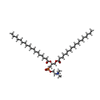 ChemComp-PC1: |
-Experimental details
-Structure determination
| Method | cryo EM |
|---|---|
 Processing Processing | single particle reconstruction |
| Aggregation state | particle |
- Sample preparation
Sample preparation
| Buffer | pH: 7.4 |
|---|---|
| Vitrification | Cryogen name: ETHANE / Instrument: FEI VITROBOT MARK IV |
- Electron microscopy
Electron microscopy
| Microscope | FEI TITAN KRIOS |
|---|---|
| Image recording | Film or detector model: GATAN K3 (6k x 4k) / Average electron dose: 50.0 e/Å2 |
| Electron beam | Acceleration voltage: 300 kV / Electron source:  FIELD EMISSION GUN FIELD EMISSION GUN |
| Electron optics | Illumination mode: FLOOD BEAM / Imaging mode: BRIGHT FIELD |
| Experimental equipment |  Model: Titan Krios / Image courtesy: FEI Company |
 Movie
Movie Controller
Controller




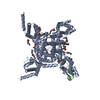

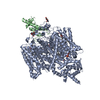
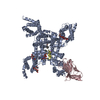
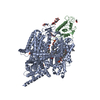
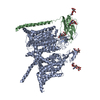
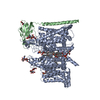


 Z (Sec.)
Z (Sec.) Y (Row.)
Y (Row.) X (Col.)
X (Col.)





















































